By Rollo Collins and Francesca Gentile
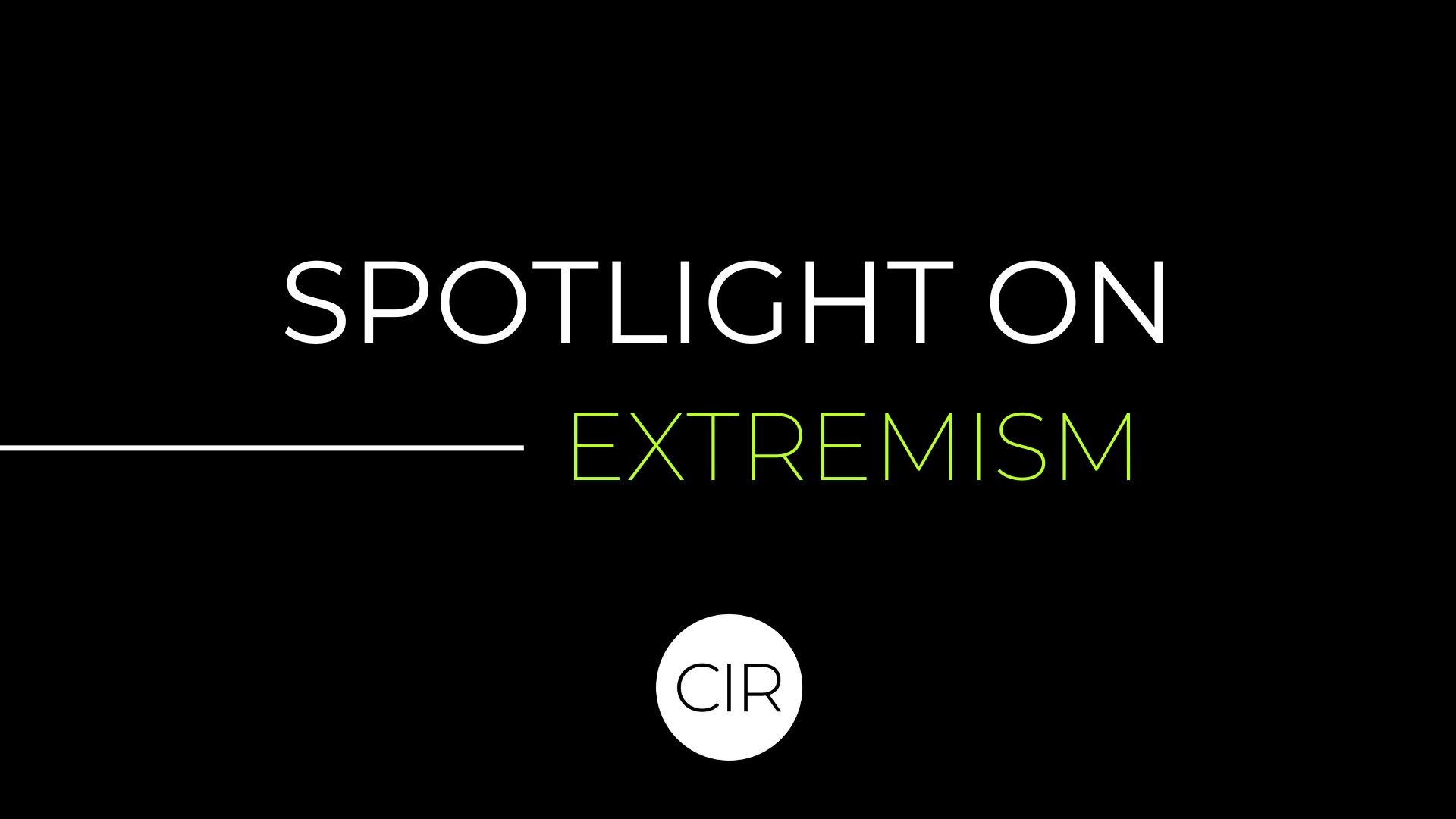
The second article of our new series “Spotlight on Extremism” looks into those conspiracy theories that emerged around the attack in May 2023 in Allen Texas, on both mainstream and fringe social media platforms.
The Centre for Information Resilience (CIR) has redacted most links due to privacy concerns and to avoid amplifying harmful content. Upon request, CIR can share any relevant data.
On 6 May 2023, a gunman opened fire in an outlet centre in Allen, Texas. Within hours of the attack, conspiracy theories started to surface online both in relation to the shooting and to the perpetrator’s identity. Once the perpetrator was named and evidence of his neo-Nazi beliefs emerged, the conspiracies increased. Members of the far-right took to X (formerly Twitter) to denounce mainstream media for allegedly spreading fake news on the attack and to call out the impossibility of the perpetrator’s white supremacist views, given his Hispanic background.
The following article will shed light on some of the conspiracy theories that surfaced on both mainstream social media platforms (such as X, formerly Twitter) and on fringe media platforms (such as 4chan) after this event. Similar narratives were shared on both platforms, with members of the far-right community spreading conspiracies on the attack, including calling it a psychological operation (or ‘psy-op’)1, on the perpetrator and against mainstream media. CIR researchers have found that those far-right influencers who were directly mentioned on the shooter’s social media, such as Tim Pool and Nick Fuentes, have made deliberate attempts to both distance themselves from the attack while also echoing conspiracy theories.
This analysis shows how members of the far-right community strategically spread conspiracy theories to advance their agenda, by reaching out to audiences on both mainstream and fringe social media platforms. As mentioned in CIR’s previous Spotlight article, after Elon Musk became X (formerly Twitter)’s CEO, the platform has less content moderation. Some researchers have argued that this has led to more users spreading hate speech, conspiracy theories and mis/disinformation.2 Despite this, some individuals and far-right influencers appear to prefer fringe platforms, given their more lenient content moderation policies.
As users with extreme views turn towards these fringe platforms, echo chambers are created in which like-minded individuals connect with one another, reinforcing and radicalising specific viewpoints. Monitoring both mainstream and fringe social media platforms is important to understand and counter the tactics and narratives used by far-right extremists.
What happened: the perpetrator and the attack
On 6 May 2023, Mauricio Garcia carried out a mass shooting at an outlet centre in Allen, Texas. The perpetrator killed eight people before he was shot by a police officer at the scene. Garcia was armed with multiple weapons (all legally purchased), including three he brought with him for the attack.
Although the perpetrator did not leave a manifesto behind, his ideology could be understood through his social media activity. Garcia had an account on YouTube as well as on the Russian social media platform ‘Odnoklassniki’ (OK.ru). For both platforms, Garcia used the name “PsychoVision5”. While his YouTube account was suspended (possibly due to the content shared on it3), his OK account contained pictures of himself (including his Nazi tattoos – a Swastika on the left shoulder and SS bolts on the right arm), detailed information on the outlet centre in Allen, Texas and posts exposing his ideology. Most of his posts included ethnic/racial slurs (against Muslim, Jewish and Asian communities), misogynistic and incel-related content4 and also far-right and white supremacist views.
An investigation by the Global Project Against Hate and Extremism analysed the content shared by Garcia. On top of promoting white supremacist symbols (such as swastikas, SS bolts and neo-Nazi runes) in his content, Garcia also praised the Daily Stormer (a neo-Nazi and white supremacist website), Nick Fuentes (a white supremacist livestreamer and political commentator) and the perpetrators of the 2023 Nashville school shooting5 and the 2014 Isla Vista attacks6. His posts also demonstrated a belief in conspiracy theories, including those relating to anti-Semitism and the Great Replacement Theory.7 In many instances, he called for the need to “make America white again” and the desire to eliminate Jews by “mak[ing] it punishable by death to be Jewish.”8
In addition to the white supremacist narratives he shared online and his neo-Nazi tattoos, Garcia’s connection to the far-right was further ascertained by a patch on his bullet-proof vest. The patch, which reads “RWDS” or “Right Wing Death Squad,” is usually used by extreme far-right groups. Originally, the phrase was used to describe the death squads created to kill communists/leftists under Augusto Pinochet’s regime. Patches similar to the one Garcia had, have been used by members of the Proud Boys as well as individuals who joined the “Unite the Right” rally in Charlottesville, Virginia, in 2017.
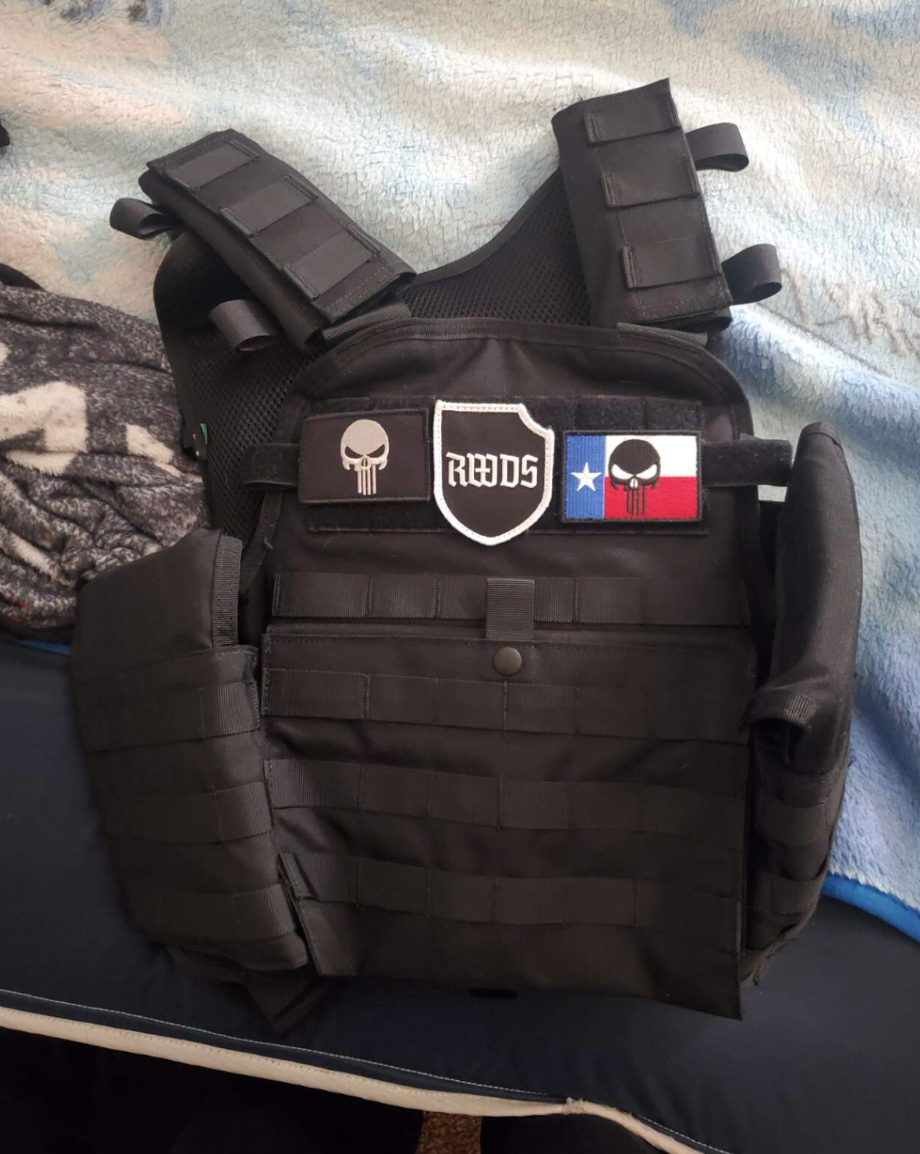
Figure 1: image taken from Bellingcat’s investigation, showing the vest that Garcia used during the attack with the RWDS patch.
Mainstream social media: X (formerly Twitter) and conspiracy theories
Across the conservative ideological spectrum, a persistent conspiracy theory referring to the attack as a ‘psy-op’ or psychological operation appeared in the days and weeks following the identification of the shooter. Much of this focus was levelled at Bellingcat, an investigative journalism outlet that was responsible for unveiling the shooter’s OK profile, including posts and images featuring tattoos and ideological convictions. Due to the nature of their reporting, much of which focuses on exposing Russian intelligence and information operations, Bellingcat has been the repeated target of conspiracy theories, with users falsely claiming they receive funding from US intelligence agencies.
Elon Musk amplified these ‘psy-op’ narratives by calling out Bellingcat for their investigation on Garcia, as well as commenting on a couple of posts shared by “The Redheaded Libertarian”. The account is owned by Josie Glabach, a TimCast9 news contributor, and is used to regularly spread disinformation on a variety of topics. Although she has accounts on different platforms (including Gab and YouTube), she is most active on X (formerly Twitter). In the screenshots below, Musk can be seen amplifying the narrative of the attack being a psy-op.
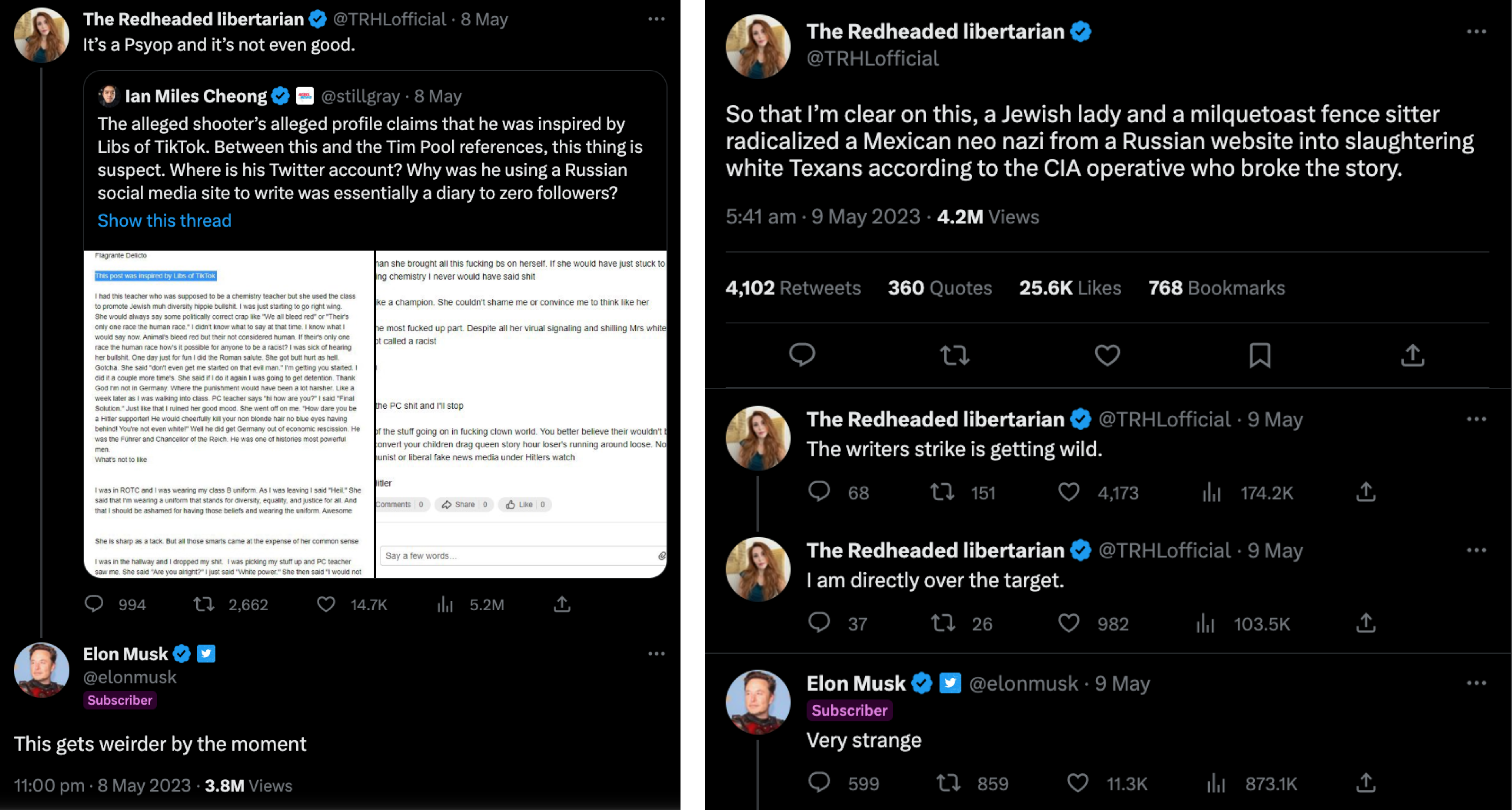
Figure 2 & 3: (left) screenshot of a post by the Redheaded Libertarian calling the attack in Texas a “psy-op” and Musk’s comment; (right) another screenshot of a post from the Redheaded Libertarian and Musk’s comment.
Users on X (formerly Twitter) spread the narrative that Garcia belonged to a “Mexican gang” and for this reason, could not be carrying out attacks in the name of white supremacy (screenshots below). In some cases, accounts also included a mugshot picture of another Mauricio Garcia and claimed he was the real perpetrator and not a white suprematist/MAGA supporter but a member of a Mexican cartel.
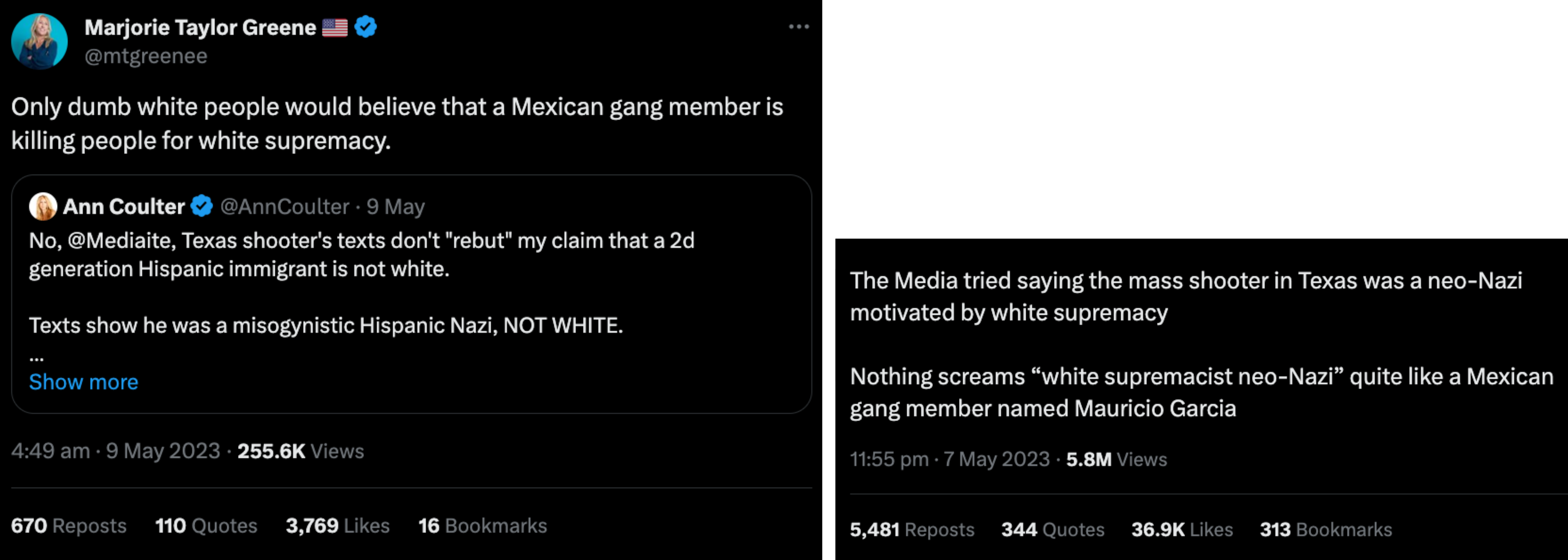
Figure 4 & 5: (left) screenshot of post shared by Congresswoman Marjorie Taylor Greene claiming that the attacker could not be a white supremacist given his ethnicity; (right) another account on X (formerly Twitter) spreading a similar narrative (image redacted for privacy reasons).
Some accounts used humour and mockery to discredit news from mainstream media and ultimately call out their perceived fake information. For example, in response to an article written by the Washington Post on Garcia’s neo-Nazi beliefs, the Redhead Libertarian mocked Garcia’s non-English name, thus, implying the impossibility of him being a neo-Nazi. Similarly, Mindy Robinson, co-founder of the America Happens Network (a conservative media outlet that spreads disinformation and far-right conspiracy theories), called out mainstream media for being “out of control” and spreading what she considers an anti-American narrative (screenshot below).
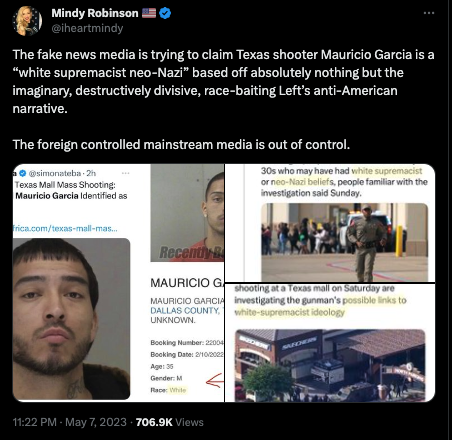
Figure 6: screenshot of a post shared by Mindy Robinson claiming that mainstream media was spreading false information on the attack.
Another narrative that appeared on X (formerly Twitter) included mentions of Garcia and neo-Nazis in Ukraine. Some accounts believed that the pictures circulating of Garcia’s Nazi tattoos were in fact of a Ukrainian soldier, others instead claimed that given Garcia’s neo-Nazi beliefs he would be supporting the Nazis in Ukraine (screenshot below).

Figure 7: user on X (formerly Twitter) amplifying the claim that the perpetrator supported Nazis in Ukraine.
With Musk’s takeover of X (formerly Twitter), the platform has become a place where individuals seek free speech and what they consider to be the ‘real truth’, replicating some alt-tech platforms.10 A decline in trust towards mainstream media has seen a rise in individuals believing in, amplifying, and spreading conspiracies or alternative narratives on events.11
Fringe media: 4chan and far-right influencers
On 4chan’s /pol/ board12, a notorious imageboard linked to the incubation and proliferation of far-right ideology, the response to the Allen shooting both at the time and after the unveiling of Garcia’s identity was that of conspiracy and suspicion. In several threads, users labelled the shooter as a ‘glowie’ and suggested the attack “glowed” – a common epithet used to describe acts of violence, particularly from white supremacists, that are supposedly orchestrated by the deep state or the US intelligence community.13 Specifically, some users claimed the final paragraph of the shooter’s manifesto was written by AI after they analysed the text with ZeroGPT14, further indicating “another false flag [sic] psyop” (screenshot below). Others challenged the shooter’s tattoos, claiming the first, a tattoo with the logo of the city of Dallas, was gang related, whilst the other, a prominent ‘SS’ symbol on his arm, had been altered or manipulated by users online.
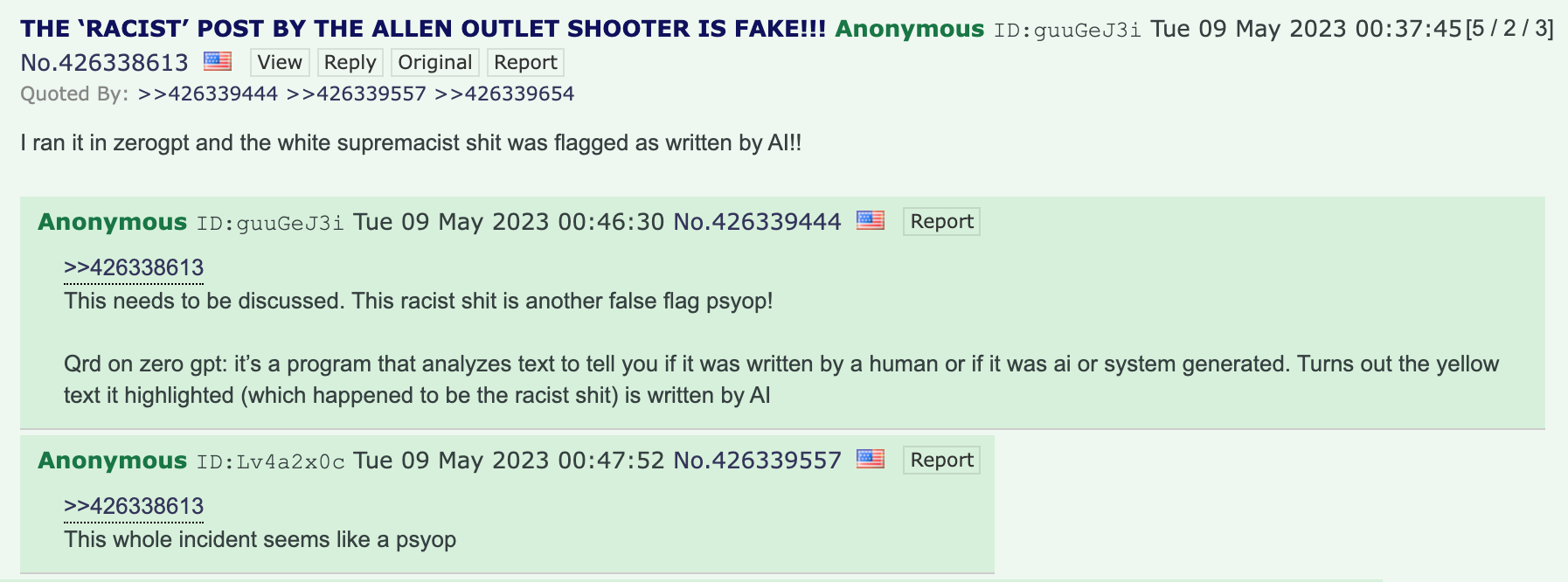
Figure 8: screenshot of a conversation regarding the shooter’s manifesto on 4chan’s /pol/ board.
Aside from 4chan’s /pol/ board, several prominent far-right figures (who, given their extremist views, are mostly not on mainstream media platforms) echoed these narratives on their fringe media sites.
Nick Fuentes, on his ‘America First with Nicholas J. Fuentes’ live show, claimed the shooter had “no affinity to whites”, quoting the shooter’s writing and perception that “whites are a loser race”. In a later segment, Fuentes stated that “there isn’t a white supremacist problem in the country”, claiming that whenever a far-right shooting takes place, they are “fake in almost the same way”, with no link between the manifesto and its author.
Andrew Anglin, founder of far-right website ‘The Daily Stormer’, whose writings were quoted by Garcia, built on this narrative, emphasising that Garcia’s use of ‘tactical gear’ was ‘convenient’. “If you think the government wouldn’t murder some guy from the internet, then send a CIA agent in to shoot random people, then place the body of the rando [sic] at the scene, then you’re delusional,” he wrote.15
Whether from an ‘influencer’ or a grassroots perspective, the rationale in prescribing the Allen shooting as a ‘psy-op’, something that has become an instinctive reaction following reports of a far-right attack, remains largely unchanged. From those seeking to influence or gain a totemic status within the movement, such as content creators, labelling an attack directly attributed to their beliefs or content as a ‘psy-op’ presents an opportunity to avoid and challenge personal culpability. In an episode of Timcast IRL, Tim Pool’s regular YouTube livestream, Pool and his colleagues repeatedly echoed conspiracy theories, debasing Bellingcat’s reputation and claiming the media were pushing an agenda to deplatform Pool.
From the grassroots perspective, much of the ‘psy-op’ discourse revolves around the perception that the media, or those responsible for linking the shooting to far-right ideology, are seeking to both undermine the conservative movement and to impose stricter gun laws (as mentioned by users on 4chan). It is likely that amongst those on fringe far-right sites such as 4chan and 8kun, paranoia over deplatforming, as was the case with 8chan after a series of shootings in 2019, has resulted in a germination and exacerbation of this conspiratorial thinking. Similarly, a refusal to accept that attacks like the Allen shooting are inspired by far-right ideology, is an attempt to distance the ideology itself from violence, presenting it as a rational and unproblematic set of political beliefs.
Conclusion
This article investigated the most common conspiracy theories spread during and after the Allen, Texas attack in May 2023. The conspiracies shared were both in relation to the shooting itself (with claims of it being a ‘psy-op’) and to the perpetrator’s identity and connection to the far-right. CIR researchers also found that for those far-right influencers directly mentioned in the shooter’s social media (such as Tim Pool and Nick Fuentes), there was a deliberate attempt to both distance themselves from the attack and to echo conspiracy theories.
Members of the far-right community took to their mainstream social media accounts and fringe platforms to amplify these conspiracies. On X (formerly Twitter), individuals such as Elon Musk and Congresswoman Marjorie Taylor Greene further promoted these conspiracies, ultimately normalising these narratives and creating an environment in which reliable information on mainstream social media might be more difficult to find.16
Fringe platforms also played a crucial role in the amplification of conspiracy theories. Far-right extremists and known influencers might prefer these platforms due to their more lenient content moderation policies as well as also the environment that these generate. Fringe platforms create echo chambers where like-minded individuals can chat and reinforce their belief system, making it easier for far-right extremists/groups to advance their agenda.
After a far-right-related attack, the conspiracies that are amplified seek to increase distrust in mainstream media; to distance the far-right ideology (that inspires an attack) from the violence itself, with members of the far-right community refusing to accept that such far-right-inspired attacks are possible; and to recruit and radicalise individuals to far-right groups and mobilise them to carry out further violence.
Therefore, moving forwards, carrying out research and monitoring both types of platforms is necessary to fully understand and counter the narratives and tactics used by the far-right community.
Rollo Collins is an Open-Source researcher at the Centre for Information Resilience, specialising in civilian harm and human rights violations during the Russian invasion of Ukraine, online disinformation, and the modern far-right.
Francesca Gentile is an Open-Source researcher at the Centre for Information Resilience, specialising in disinformation narratives, social media monitoring, information operations and far-right extremism.
“Spotlight on Extremism” is a series of articles based on investigations our CIR analysts conducted into some of the extremist ideologies that are circulating online. The articles will cover multiple narratives, events and concepts related to the broader sphere of extremism with the aim of analysing the impact it has on societies and furthering an understanding of the concept.
1 A psychological operation (or a ‘psy-op’) refers to the military operations carried out to influence the emotions and behaviours of certain individuals, organisations and governments. According to the Anti-Defamation League, “conspiracy theorists have co-opted the term to suggest that various conspiracy theories and world events are fomented by the government and global elites to distract “truth seekers” and sow confusion.” Anti-Defamation League (2024) Available at: https://www.adl.org [accessed 18 January 2024]
2 BBC Monitoring (March 2023) Available at: https://www.bbc.com [accessed 18 January 2024]; Warzel (23 May 2023) The Atlantic, Available at: https://www.theatlantic.com; Center for Countering Digital Hate (June 2023) Available at: https://counterhate.com [accessed 19 December 2023]; Frenkel and Conger (December 2022) The New York Times, Available at: https://www.nytimes.com
3 Compared to OK, YouTube has stricter content moderation policies in place. According to their guidelines, any video that “contains hate speech, predatory behaviour, graphic violence, malicious attacks, and content that promotes harmful or dangerous behaviours” is not allowed and therefore taken down.
4 The Anti-Defamation League defines incles, or involuntary celibates, as: “heterosexual men who blame women and society for their lack of romantic success.” Incels have carried out a series of violent attacks targeting women. In some of his posts, Garcia identified as an incel and used derogatory terms to talk about women. Anti-Defamation League (2023) Available at: https://www.adl.org [accessed 18 January 2024]
5 On March 27 2023, Aiden Hale, also known as Audrey Elizabeth Hale, carried out a mass shooting at a private Christian school, the Covenant school, in Nashville, Tennessee.
6 On May 23 2014, Elliot Rodger carried out multiple attacks near the campus of the University of California, Santa Barbara in Isla Vista, California.
7 The Great Replacement Theory, popularised by Renaud Camus, has inspired many attacks carried out by far-right extremists/white suprematists. The theory was created to denounce the “replacement” and “contamination” of the white population by non-white communities. Additional information can be found from the Counter Extremism Project (2023) Available at: https://www.counterextremism.com [accessed 18 January 2024]
8 Global Project Against Hate and Extremism (9 May 2023) Available at: https://globalextremism.org [accessed 18 January 2024]
9 TimCast.com is owned and operated by Tim Pool, a conservative commentator with right-wing views, with the aim of countering the alleged fake news spread by mainstream media.
10 Alternative (or ‘alt-tech’) platforms are social media platforms that have become popular among members of the far-right community given the fact that they have little to no content moderation policies. Mulhall (March 2022) Hope not Hate, Available at: https://hopenothate.org.uk
11 Klepper (2022) Associated Press, Available at: https://apnews.com
12 /pol/ is the abbreviated term for the “politically incorrect” discussion board on 4chan.
13 Bergius (2021) Göteborgs Universitet, Available at: https://gupea.ub.gu.se – The term ‘glowing’ refers to individuals or events that ‘glow in the dark’ and are conspicuous amongst the broader 4chan /pol/ community.
14 ZeroGPT is an AI detection tool which analyses text to determine its origin and if it was written by AI.
15 The Daily Stormer (9 May 2023) Link available on request.
16 Dooley (October 2023) Forbes, Available at: https://www.forbes.com; McCluskey (November 2022) TIME, Available at: https://time.comr

